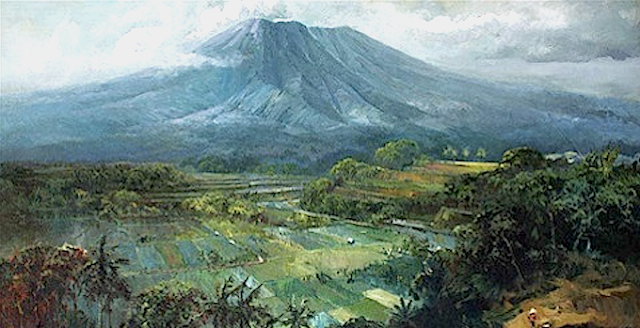Le Priangan / Parahyangan (nd)
Indonésie (Java occidental)
In "Een berg in de Preanger," 1935, Tropen museum
La chaine montagneuse
Le Priangan, Parahyangan ou Preanger est une région montagneuse du pays Sunda dans la province indonésienne de Java occidental. Le nom Parahyangan vient de hyang qui veut dire « dieu » ; il signifie donc « la demeure des dieux » et les anciens Indonésiens croyaient que les dieux séjournaient dans les sommets. On retrouve cette étymologie hyang dans d'autres toponymes de Java, comme le plateau de Dieng dans le centre, ou le plateau de Yang dans l'est. La superficie totale de cette région est de 21 524 km2 (soit un peu moins du 1/6 de Java). Le Priangan est bordé à l'ouest par les kabupaten de Bogor et Sukabumi, au nord par ceux de Karawang, Purwakarta, Subang et Indramayu, au nord-est par ceux de Majalengka et Kuningan, à l'est par la rivière Citanduy qui marque la frontière avec la province de Java oriental, et au sud par l'océan Indien.
Le peintre
Abdullah Sudirohusodo est un peintre indonésien, le fils adoptif du Dr Wahidin Sudirohusodo, une figure éminente du mouvement national indonésien, fondateur du Boedi Oetomo. Dans les pas de son père adoptif, Abdullah entre à l’école de médecine de Batavia (aujourd’hui Jakarta). Il poursuit ensuite ses études aux Pays-Bas. C'est aux Pays Bas qu'il se tourne vers l’art de la peinture et entre à l’école des beaux arts de La Haye.
À son retour en Indonésie, Abdullah a poursuivi sa carrière de peintre. Il participa notamment à la revue Bandera Wollanda, le « drapeau hollandais », organe de la colonisation hollandaise.
Abdullah est considéré comme le premier peintre indonésien au 20e siècle, de style romantique. Il est inclus dans un mouvement artistique nommé « Mooi Indie » qui peut être traduit par « Les Belles Indes ». Plusieurs expositions lui fuirent consacrée mais dans les grands musées indonésien mais il préférait vivre retiré à Bandung pour être proche de la nature qu’il aimait peindre.
Ses peinture de paysage sont à l'origine même l’embryon de la peinture classique indonésienne. Elles influencèrent tous les peintres naturalistes en représentant des scènes locales.
Ses paysages de montagne ont été acquises pour constituer la collection du premier président de la République d’Indonésie, Bung Karno-Soekarno amateur d’art éclairé, pour qui la peinture naturaliste restait la plus fidèle représentation de l’identité nationale Indonésienne. Il créa d’ailleurs un musée national présentant ses différentes acquisitions ainsi que ses propres créations.
Abdullah Suriosubroto est très célèbre pour ses œuvres « Fôret de bambou », « Paysage indonésien », « Rizière » et « La rivière ».
Abdullah est le père des célèbres peintres Sudjono Abdullah et Basoeki Abdullah et de la sculptrice Trijoto Abdullah.
________________________________________
2025 - Gravir les montagnes en peinture
Un blog de Francis Rousseau
-%20%20Een%20berg%20in%20de%20Preanger%20-%201935%20Tropen%20museum%20.jpg)
-%20Pemandangan%20Sawa%20dan%20Gunung%20b.jpg)





